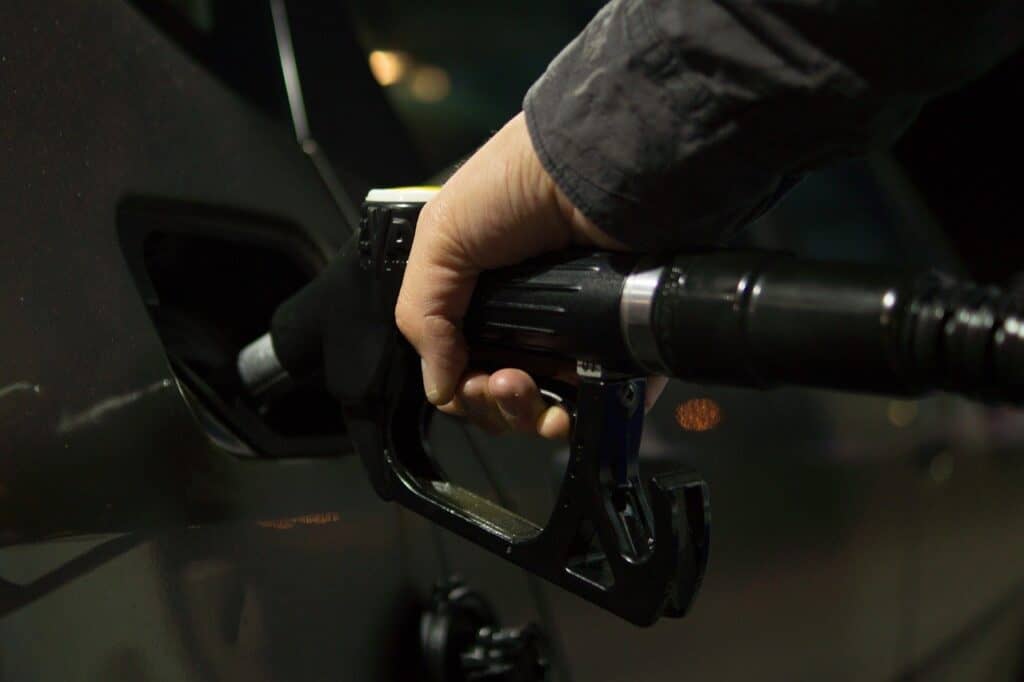Diesel fuel only makes up about 3% of all vehicles in the United States, but it is much more popular in other parts of the world, like in Europe. Wherever you are, diesel is seen at many gas filling stations and is quite common. Most would assume that diesel fuel is highly flammable, but is that true? Does it burn or even explode the way gasoline (petrol) will?
Diesel fuel can catch fire and is classified as a flammable liquid according to OSHA, because it has a flashpoint above 199.4 degrees Fahrenheit. The flashpoint of diesel is approximately 140 degrees Fahrenheit (60 Celsius). This means in most ambient temperatures it will not ignite.
We will talk about the differences between flammable and combustible liquids below. We will also take a look at what it takes for diesel fuel to catch fire…
Your # 1 priority is keeping your family safe. As a firefighter, I recommend everyone has updated smoke detectors that don’t require battery changes, like these ones from Kidde, a fire extinguisher, like this one from Amerex, and a fire escape ladder if you have bedrooms above the first floor, I recommend this one from Hausse.
Also read: What Makes Something Flammable?
Flammable or Combustible

Though they may be used as such, flammable and combustible do not mean the same thing.
Sometimes people will say, “Flammable means it will catch fire and combustible means it will explode when ignited.” That isn’t totally true.
There are specific criteria set by OSHA (Occupational Safety and Health Administration) about flammable or combustible liquids in the standard 29 CFR 1910.
OSHA used to defines them as:
Flammable Liquids: Any liquid that has a flashpoint below 100 degrees Fahrenheit (37.8 Celsius).
Combustible Liquids: Any liquid that has a flashpoint at or above 100 degrees Fahrenheit (37.8 Celsius).
However, that has changed.
OSHA now says that any liquids with a flashpoint below 199.4 degrees Fahrenheit (93 Celsius) is a flammable liquid.
Flashpoint: The lowest temperature at which a substance will give off enough vapor to ignite (catch on fire).
Note: Liquids and solids don’t burn the way they are. They give off flammable vapors, depending on the temperature, that can ignite in the right concentrations.
Therefore, we can see that flammable liquids are more dangerous and can catch fire more easily (at a lower temperature) than other liquids. However, both flammable and non-flammable liquids can be a fire hazard, the distinction is how flammable and at what temperature.
Also read: Is Transmission Fluid Flammable? Yes and No…
What is the Flashpoint?
Diesel fuel has a flashpoint range between 100 and 180 degrees Fahrenheit (37 to 82 degrees Celsius). The range of flashpoints is due to there being a few different types of diesel fuel (1,2,3,4).
The number that is most commonly used as the flashpoint of diesel is 140 degrees Fahrenheit or 60 degrees Celsius.
Because the flashpoint of diesel is above 199.4 degrees Fahrenheit, it is classified as a flammable liquid.
Compare this to gasoline (petrol) which has a flashpoint of -45 degrees Fahrenheit (-43 Celsius). The lower flashpoint is necessary for the way a gasoline engine works.
Gasoline is classified as a flammable liquid as well. The lower flashpoint is necessary for gasoline.
For a gasoline engine to work, gasoline is mixed with oxygen and a spark from a spark plug ignites the mixture. These sparks cause the mini-explosions that push the pistons and power the motor. For this reason, the gasoline needs to be able to ignite in normal, ambient temperatures to drive the engine.
Diesel, however, does not work the same way.
There are no spark plugs in a diesel motor. Instead, it uses glow plugs to heat the fuel mixture to provide the combustion needed for the engine. Diesel fuel can have a higher flashpoint because a spark isn’t needed for the combustion.
Different fuels with different properties for different applications.
Also read: Is Motor Oil Flammable? You May Be Surprised and How Long Is Spilled Gasoline Flammable For?
Can You Light Diesel with a Lighter?
So, if diesel fuel is combustible rather than flammable, does that mean it won’t light on fire?
It depends on the conditions!
If the temperature of the environment or other heat sources cause the fuel to heat above its flashpoint (varies by type of diesel)l, it will start giving off diesel fumes that are flammable, and then, yes, it will ignite with a spark or flame.
However, if the diesel is under the 126 to 205 degree Fahrenheit flashpoint (which is usually the case) it will not light with a lighter or other ignition source.
Take a look:
We can see that once the diesel fuel is heated up to its flashpoint, it will catch fire, but not at most ambient temperatures.
Also read: Is Power Steering Fluid Flammable?
Conclusion
We can see that diesel fuel is different in many ways from regular gasoline. While they can both be a fire hazard, only gasoline is technically a flammable liquid. Diesel is instead classified as a combustible liquid.
But make no mistake about it, diesel can and will burn. It can fuel fires and be very dangerous in certain conditions.
Related Articles
Is Diesel Exhaust Fluid (DEF) Flammable?
Is Hydraulic Fluid Flammable? Yes and No…
Are Tires Flammable? You May Be Surprised…

